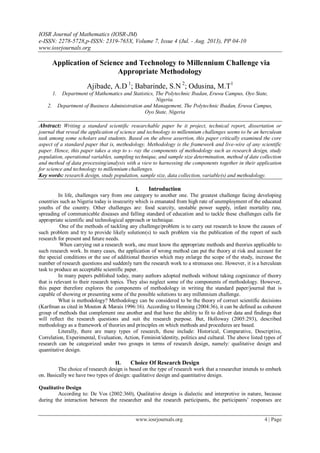This document discusses the importance of methodology in scientific research papers that aim to apply science and technology to address millennium challenges. It defines methodology as the framework and methods used in a research study. The document examines key components of methodology, including research design, study population, variables, sampling techniques, sample size determination, data collection methods, and data analysis. It provides examples for how to determine these methodological components and stresses that applying the appropriate methodology is essential for producing valid, high-quality research that can help solve important problems.






![Methodology As A Key Factor In The Application Of Science And Technology To Millenium
www.iosrjournals.org 10 | Page
Verification validation of the data
During data entry, mistakes will definitely creep in. The computer can print out the data exactly as it
has been entered, so the printout can be checked visually for obvious errors, (e.g., exceptionally long or short
lines, blanks that should not be there, alphabetic codes where numbers are expected and wrong codes)
Programming
A certain amount of basic knowledge of computer programming is needed to give the appropriate
commands during the analysis of data.
Computer outputs
The computer can do most of the analysis and the results can be printed. It is important to decide
whether each of the tables, graphs, charts and statistical tests that can be produced makes sense and should be
used in your report. That is why one needs to plan or design the method of data analysis at initial stage of
research work.
IV. Conclusion
No meaningful development strategy for combating the millennium challenges can be effective without
development of adequate techniques in science and technology. Based on the above statement, there is no doubt
that in writing a paper or journal that capable of providing solutions to any of the millennium challenges, the
concepts of the methodology (key aspect of paper or journal) should not be overlooked.
References
[1]. Creswell, J.W (2003). Research Design: Sage publications, London
[2]. Miles, M.B et al (1974). Quantitative Data Analysis 2nd
edition: Sage publications, London
[3]. Altman, D.G (1991). Practical Statistics for Medical Research: Chapman and Hall, London.
[4]. Colton, T. (1974). Statistics in Medicine: Boston Little, Brown and Company 9INC.
[5]. Corlien, M.V; Indra Pathmanathan and Ann Brownlee (2003). Designing and conducting health systems research projects: Volume
1 Proposal development and fieldwork: KIT/IDRC
[6]. Degu, G and Tessema, F. Biostatistics for Health Science Students: lecture note series: Department of Community Health, Jimma
Institute of Health Sciences.
[7]. Development in primary health care (1998). Ethical considerations in research focus ESTC-EPHA/CDC PROJECT (2004),
Training modules on health research.
[8]. Fletcher, M (1992), Principles and Practice of Epidemiology. Department of Community Health, Faculty of medicine, Addis Ababa
University.
[9]. Manktelow, B; Hewitt, M.J and Spiers, N (2002). An introduction to Practical Statistics Using SPSS: Trent Focus, Gondar (1995).
Manual for field training Jimma (1996). Manual for student research project
[10]. Mathers, Nigel; Howe, Amanda and Hunn, Amanda. Trent focus for research and The Carter Center 9EPHTI), Addis Ababa.](https://image.slidesharecdn.com/b0740410-150428030433-conversion-gate02/85/B0740410-7-320.jpg)